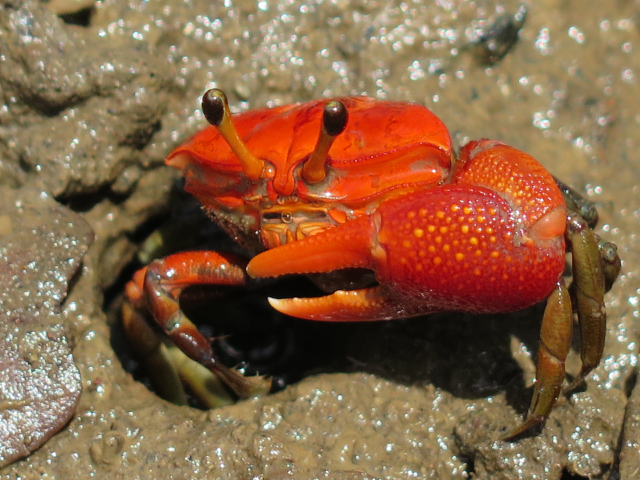20/08/2021 | Benthic invertebrate species diversity plays a major role in the conservation of mangroves and their ecosystem services. This is the result of a global synthesis of an international researcher consortium including the ZMT, that was recently published in the high-ranking international journal Proceedings of the National Academy of Sciences. An important contribution were the results obtained by ZMT researcher Inga Nordhaus over many years in the species-rich mangroves of Indonesia in the frame of the BMBF-funded research programme SPICE. Here an interview with Tim Jennerjahn, then head of the SPICE research collaborative on the "Ecology of mangroves and the sustainability of their resources".
What were the initial questions of the study?
Tim Jennerjahn: How resilient or vulnerable are mangroves to human-induced environmental change? One indicator of this are benthic invertebrates, which perform important functions (supplying nutrients and oxygen, aerating the soil, influencing the carbon cycle). Will these functions be maintained if their species numbers decline? What is their taxonomic and functional diversity?
What exactly did you investigate?
Tim Jennerjahn: An international consortium, in which ZMT researcher Inga Nordhaus participated, compiled data from 16 different mangrove areas worldwide, representing the entire spectrum from low to high diversity of benthic invertebrates. Crab and mollusk communities were used to determine the ratio of taxonomic to functional diversity and the functional redundancy. The results were related to those of other, mostly tropical, coastal ecosystems to determine if mangroves are less or more vulnerable or resilient than other ecosystems.
What new findings emerged?
Tim Jennerjahn: Mangroves have a lower functional redundancy and are therefore more vulnerable than other ecosystems, when species are lost. Mangrove forests in Southeast Asia with higher species numbers are less vulnerable than other less species-rich mangrove ecosystems. Mangroves that are small in area also have a high species diversity and are therefore just as worthy of conservation as large mangroves.
What conclusions can be drawn from this?
Tim Jennerjahn: Mangroves are particularly susceptible to species loss because many functions are also quickly lost as a result. Therefore, the removal of individual species from the system, for example through overfishing, can also lead to the loss of important functions that endanger the entire ecosystem.
When assessing the status or importance of mangrove areas, one should not only go by their size, but also include species diversity. Maintaining biodiversity as an important factor in functionality and ecosystem service supply is of greater importance for mangroves than for other coastal ecosystems and should be given special consideration in protection or restoration efforts.
Why do the results have far-reaching significance?
Tim Jennerjahn: Mangroves and their biodiversity must be conserved, because they have important functions and provide ecosystem services. Mangroves are important for coastal protection and climate regulation, the benthic invertebrates contribute to this, and furthermore they are also an important food source for animals and humans.
Publication
Stefano Cannicci, Shing Yip Lee, Henrique Bravo, Jaime Ricardo Cantera-Kintz, Farid Dahdouh-Guebas, Sara Fratini, Marco Fusi, Pedro J. Jimenez, Inga Nordhaus, Francesca Porri, Karen Diele (2021). A functional analysis reveals extremely low redundancy in global mangrove invertebrate fauna. Proceedings of the National Academy of Sciences Aug 2021, 118 (32) e2016913118; DOI: 10.1073/pnas.2016913118





